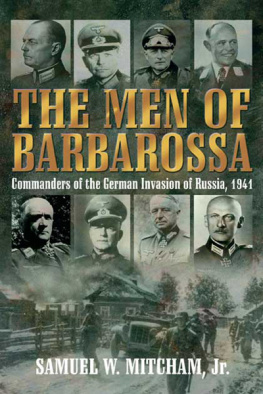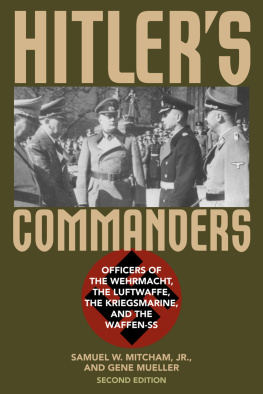Mitcham W. Samuel - The Final Destruction of the Wehrmacht
Here you can read online Mitcham W. Samuel - The Final Destruction of the Wehrmacht full text of the book (entire story) in english for free. Download pdf and epub, get meaning, cover and reviews about this ebook. year: 2021, publisher: Regnery History, genre: History. Description of the work, (preface) as well as reviews are available. Best literature library LitArk.com created for fans of good reading and offers a wide selection of genres:
Romance novel
Science fiction
Adventure
Detective
Science
History
Home and family
Prose
Art
Politics
Computer
Non-fiction
Religion
Business
Children
Humor
Choose a favorite category and find really read worthwhile books. Enjoy immersion in the world of imagination, feel the emotions of the characters or learn something new for yourself, make an fascinating discovery.

- Book:The Final Destruction of the Wehrmacht
- Author:
- Publisher:Regnery History
- Genre:
- Year:2021
- Rating:3 / 5
- Favourites:Add to favourites
- Your mark:
- 60
- 1
- 2
- 3
- 4
- 5
The Final Destruction of the Wehrmacht: summary, description and annotation
We offer to read an annotation, description, summary or preface (depends on what the author of the book "The Final Destruction of the Wehrmacht" wrote himself). If you haven't found the necessary information about the book — write in the comments, we will try to find it.
The Final Destruction of the Wehrmacht — read online for free the complete book (whole text) full work
Below is the text of the book, divided by pages. System saving the place of the last page read, allows you to conveniently read the book "The Final Destruction of the Wehrmacht" online for free, without having to search again every time where you left off. Put a bookmark, and you can go to the page where you finished reading at any time.
Font size:
Interval:
Bookmark:


Copyright 2021 by Samuel W. Mitcham Jr.
All rights reserved. No part of this publication may be reproduced or transmitted in any form or by any means electronic or mechanical, including photocopy, recording, or any information storage and retrieval system now known or to be invented, without permission in writing from the publisher, except by a reviewer who wishes to quote brief passages in connection with a review written for inclusion in a magazine, newspaper, website, or broadcast.
Regnery History is a trademark of Salem Communications Holding Corporation
Regnery is a registered trademark of Salem Communications Holding Corporation
ISBN 978-1-68451-138-9
eISBN 978-1-68451-184-6
Cover design by John Caruso
Library of Congress Control Number: 2020949471
Published in the United States by
Regnery History
An imprint of Regnery Publishing
A division of Salem Media Group
Washington, D.C.
www.RegneryHistory.com
Books are available in quantity for promotional or premium use. For information on discounts and terms, please visit our website: www.RegneryHistory.com.
T he purpose of this book is to write the military history of Nazi Germany from the latter part of 1944 until May 23, 1945the period in which Hitlers empire was finally and totally destroyed.
From June 6, 1944, until early September 1944, Hitlers Wehrmacht was smashed on both the Eastern and Western Fronts. It nevertheless made a desperate last stand and checked the Anglo-American armies in a series of battles along the Siegfried Line while simultaneously administering a stinging defeat to the British Army at the Battle of Arnhem. At the same time, it almost miraculously created an entire new panzer army, which it unleashed in the Ardennes on December 16, 1944. It was Germanys last chance offensive, and it gave the Americans, in particular, some very bad moments.
On the Eastern Front, the main focus was on Poland and Hungary. In August 1944, Romania defected from the Axis, and Germany lost most of its 6th and 8th Armies. Hungary was wavering and in September was invaded by the Soviet Union. Against seemingly overwhelming odds, Hitlers generals desperately tried to prevent the collapse of their southern flank. That they succeeded was one of the minor miracles of the war. This is where our story begins.
Since 1960, there have arisen in the Western world what might be termed social military historians. They deal with war from a sociological (or in some cases pseudo-sociological) point of view without discussing battles and campaigns, which are dismissed with a wave of the hand, if they are mentioned at all. I believe war has its sociological and philosophical elements, but it also involves strategy, operations, and tactics, as well as logistics, training, the inclination of a people to wage war, and the warrior himself, be he general or private. In other words, this book will follow a more nuts and bolts approach in which strategy, battles, and campaigns are emphasized rather than sociological motivations.
I wish to thank all those who helped in the researching, writing, and producing of this book, especially my wife, Donna. Thanks also go to the archivists and other employees at the National Archives, Washington, D.C., the Bundesarchiv, the War College, the Center of Military History, and the Imperial War Museum, as well as the late Friedrich von Stauffenberg and anyone else who shared information, advice, photographs, or memoirs with me.
Dr. Samuel W. Mitcham Jr.
Monroe, Louisiana
February 2020
T he Nazis came to power on January 30, 1933. At that time, Germany lived under the restrictions imposed by the Treaty of Versailles, which ended World War I. Its military force (the Reichswehr or armed forces) was limited to 115,000 men100,000 in the army (Reichsheer) and 15,000 in the navy (Reichsmarine)which left Germany unable to defend itself or threaten its neighbors.
Adolf Hitler changed all that, and he had an excellent foundation upon which to build. The notoriously efficient General Staff was officially abolished in 1919, but its de facto replacement, the Truppenamt (Troop Office), secretly continued to train top-level General Staff officers. Germany also continued to maintain its Wehrkreise (sometimes spelled Wehrkreisen) or German military districts, which were the heart of the German Army.
Each Wehrkreis was a corps-level, territorial command responsible for recruiting, mobilization, supply, administration, logistical support, and all military-political and military-civilian matters within its area. After Hitler renounced the Treaty of Versailles, the Wehrkreise were responsible for implementing conscription for the German Army. When the war began in September 1939, they were placed under the Home Army (also known as the Replacement Army). Their field components were designated corps headquarters and sent to combat zones. Their territorial elements remained in Germany, where older officers, often extremely capable administrators, focused on keeping the badly outnumbered German Army well-trained and in the field for the duration of the war.
Initially, there were seven Wehrkreise. By 1939, there were fifteen, numbered I through XIII, and XVII and XVIII. The Wehrkreise and their headquarters are shown on . Later, Wehrkreise XX, XXI, and General Gouvernement were added in the occupied territories. They never approached the importance of the earlier (German) Wehrkreise.
In February 1938, Hitler set up the machinery for running his war. It consisted of the High Command of the Armed Forces (Oberkommando der Wehrmacht or OKW), the High Command of the Army (Oberkommando des Heeres or OKH), the High Command of the Luftwaffe (Oberkommando der Luftwaffe or OKL), and the High Command of the Navy (Oberkommando der Kriegsmarine or OKM). The military SS (Waffen-SS) was also important by 1944, but its combat divisions remained under the operational control of the army, and there was never an Oberkommando der Waffen-SS per se.

Field Marshal Wilhelm Keitel, commander-in-chief of OKW, late 1941. Bundesarchiv Bild 183-H30220 CC BY-SA 3.0
OKW was headed by Colonel General (later Field Marshal) Wilhelm Keitel, whom Hitler once declared had the brains of a cinema usher. That was precisely what Hitler wanted: a mindless yes-man who would relay his orders to the forces without too much thought. Keitel initially tried to establish an actual high command, but OKL and OKM refused to cooperate with him, and Hitler (who practiced the political principle of divide and rule) was fine with that. By 1941, an unofficial dual command of the German ground forces had evolved. OKH directed the Eastern Front. OKW directed everything else.

Map 1.1

Hitler reviews marching infantry, Poland, 1939.
Font size:
Interval:
Bookmark:
Similar books «The Final Destruction of the Wehrmacht»
Look at similar books to The Final Destruction of the Wehrmacht. We have selected literature similar in name and meaning in the hope of providing readers with more options to find new, interesting, not yet read works.
Discussion, reviews of the book The Final Destruction of the Wehrmacht and just readers' own opinions. Leave your comments, write what you think about the work, its meaning or the main characters. Specify what exactly you liked and what you didn't like, and why you think so.







